Parallel Circuit - Complete Toolkit
Objectives
-
To recognize a parallel circuit, to distinguish it from a series circuit, and to construct and/or interpret a schematic diagram of a parallel circuit.
-
To compare the values of current and electric potential at various locations (inside and outside of the branches) within a parallel circuit and to explain the principles that form the basis of such comparisons.
-
To calculate the equivalent resistance of a parallel circuit from values of individual resistances.
-
To mathematically analyze a parallel circuit in order to relate the current value in each resistor to the battery voltage and the resistance values of the individual resistors.
-
To mathematically analyze a parallel circuit and use the Ohm’s law equation in order to determine the voltage drops across each resistor and to compare each of these values to the voltage of the battery.
Readings from The Physics Classroom Tutorial
-
Current Electricity Chapter, Lesson 4a - Circuit Symbols and Circuit Diagrams
-
Current Electricity Chapter, Lesson 4b - Two Types of Connections
-
Current Electricity Chapter, Lesson 4d - Parallel Circuits
Interactive Simulations
-
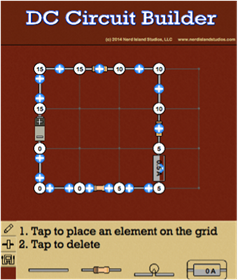 Nerd Island Studios’ DC Circuit Builder
Nerd Island Studios’ DC Circuit Builder
In cooperation with The Physics Classroom, Nerd Island Studios has produced an iPad, tablet, Chromebook, and mobile-friendly app for investigating electric circuits. Users can easily drag circuit elements onto the workspace to build any type of circuit. Battery voltage and resistance values can be easily modified, providing users with a virtual circuit kit capable of exploring circuit concepts. The DC Circuit Builder is accompanied by three different classroom-friendly and ready-to-use activities prepared by The Physics Classroom.
-
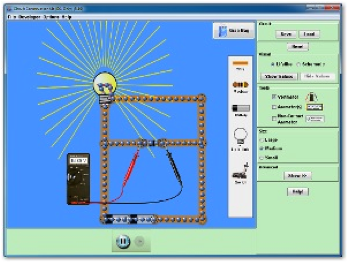 PhET DC Circuit Construction Kit
PhET DC Circuit Construction Kit
Explore basic electricity relationships in either series or parallel circuits by dragging wires, batteries, resistors, bulbs, and switches to construct a model DC circuit. Students can take measurements with realistic virtual ammeter and voltmeter. “Right click” to change the resistance and watch the effects. Note: Here’s an additional link to an activity on parallel circuits developed specifically to accompany the PhET DC Circuit simulator. http://phet.colorado.edu/en/contributions/view/3466
-
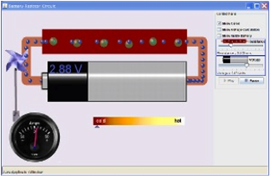 PhET Battery-Resistor Circuit
PhET Battery-Resistor Circuit
Explore a model of charge flow and resistance in this interactive simulation of a very simple battery-powered circuit. Resistance and potential difference can be adjusted to see how this affects the current. Also see the link below for a teacher-created activity to guide students in using this simulation. In the activity, they will complete charts to determine potential difference and current (given resistance) and will create graphs of voltage vs. current.
http://phet.colorado.edu/en/contributions/view/3620
-
 Build Electric Circuits: Creating Schematic Diagrams
Build Electric Circuits: Creating Schematic Diagrams
Good choice for students who want to push the envelope with circuit building. This website was developed by a microelectronics engineer in Norway, whose aim is to share the science of circuit building without using a breadboard. He walks users through freeware called “Cadsoft Eagle” to help them teach themselves the basics of digital circuit building.
Video and Animations
-
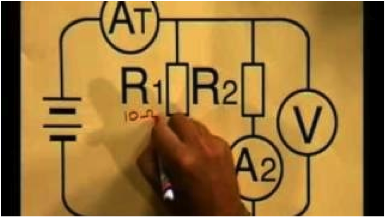 Education Commons: Potential Difference and Resistance – Parallel Circuit
Education Commons: Potential Difference and Resistance – Parallel Circuit
This 13-minute video uses animation and demonstrations to illustrate resistance in a parallel circuit. It explores how to measure current in the circuit and explains the effect on current if more resistors are added. It could be especially appropriate for students with learning disabilities or limited reading proficiency.
-
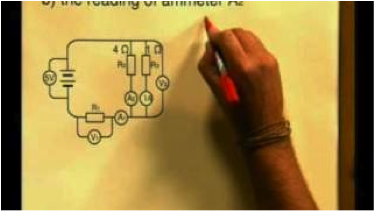 Education Commons: Potential Difference and Resistance – Circuit Calculations
Education Commons: Potential Difference and Resistance – Circuit Calculations
This 13-minute video provides highly-scaffolded support for using circuit diagrams to calculate current passing through each resistor in both series and parallel circuits. Could be appropriate for struggling learners or as review of resistance concepts in introductory physics courses.
Labs and Investigations
Demonstration Ideas
-
 MIT Tech TV: Forces on a Current-Carrying Wire Physics Demonstration
MIT Tech TV: Forces on a Current-Carrying Wire Physics Demonstration
Sometimes we focus so much on teaching the mathematics of voltage and resistance that we can forget to expose our students to the forces on a current-carrying wire. This short MIT physics demonstration shows two wires suspended vertically. The wires are connected first in series, then in parallel to a 12v battery. Is there a difference in how the wires interact in series vs. parallel? Yes. In parallel, the wires attract; in series, they repel.
-
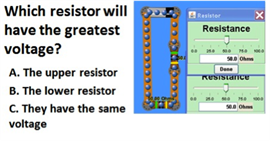 PhET Teacher Contributions: Circuit Construction Kit Presentation (Power Point)
PhET Teacher Contributions: Circuit Construction Kit Presentation (Power Point)
Set of 13 Power Point slides for classroom formative assessment on series/parallel circuits. It was developed by a PhET “Gold-Star winning” high school teacher and can be accessed as a pdf for presentation or as a Power Point document with answers provided in annotations.
Minds On Physics Internet Modules:
The Minds On Physics Internet Modules are a collection of interactive questioning modules that target a student’s conceptual understanding. Each question is accompanied by detailed help that addresses the various components of the question.
-
Electric Circuits, Assignment EC8 - Parallel Circuits Concepts
-
Electric Circuits, Assignment EC10 - Parallel Circuits Calculations
Concept Building Exercises:
-
The Curriculum Corner, Electric Circuits, Parallel Circuits
-
The Curriculum Corner, Electric Circuits, Circuit Analysis
Problem-Solving Exercises:
-
The Calculator Pad, Electric Circuits, Problems #20 - #21, #29 - #34
Link:
http://www.physicsclassroom.com/calcpad/circuits
Science Reasoning Activities:
-
Science Reasoning Center, Electric Circuits, Series and Parallel Lab
Link:
http://www.physicsclassroom.com/reasoning/circuits
Real Life Connections:
-
 TED Talks Video: Eric Giler – A Demo of Wireless Electricity
TED Talks Video: Eric Giler – A Demo of Wireless Electricity
Wouldn’t it be great to get rid of all those wires? It’s been 5 years since this somewhat iconic video hit TED Talks, but it’s definitely worth student viewing. In 2006, a team of theoretical physicists at MIT developed a technology that uses resonant energy transfer to transmit power over distance. It uses specially designed magnetic resonators to transfer the electrical energy from power sources. It might interest students to know that the technology was patented and team members formed a start-up company (WiTricity). The link below takes you to the WiTricity website and a brief tutorial in the physics behind the magnetic resonator.
http://www.witricity.com/pages/technology.html
Common Misconception:
-
More Resistors ... More Resistance?
Students become troubled by the observation that adding more resistors to a parallel circuit lowers the overall resistance of that circuit. Emphasize to students that the result is due to the fact that more pathways or branches have been provided to allow charge to flow from node to node. The Tollway Analogy discussed in the Tutorial pages (Lesson 4b of the Circuits Chapter) is an often helpful model for understanding why adding more and more resistors in branches reduces the overall resistance and increases charge flow rates.
Related PER (Physics Education Research)
-
Students’ understanding of direct current resistive electric circuits, Engelhardt and Beichner, American Journal of Physics 72 (1), 98 (2004).
This article reports on the use of the DIRECT diagnostic test (Determining and Interpreting Resistive Electric Circuit Concepts Test) to analyze student understanding of DC circuit concepts. Researchers found that both high school and college students, especially females, held multiple misconceptions – even after instruction. The main source of misconception, according to the authors, is with confusion about the underlying mechanism of electric circuits and the meaning of “current”.
Link: http://www.ncsu.edu/per/Articles/Engelhardt&Beichner.pdf
Elsewhere on the Web:
-
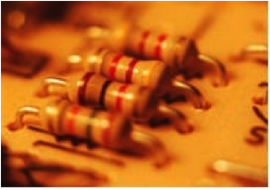 TryEngineering: Using Ohm’s Law to Build a Voltage Divider
TryEngineering: Using Ohm’s Law to Build a Voltage Divider
Completely turn-key lesson plan provides a blueprint for designing and building a voltage divider – a form of linear circuit capable of producing a wide range of output voltages. Students explore the mathematical relationships of parallel and series resistors as they build LEDs. The driving question of the lesson: How do electrical engineers apply Ohm’s Law in the design of electrical circuits?
-
 University of Oregon Physics Applets: Circuit Tool
University of Oregon Physics Applets: Circuit Tool
Investigate current flow in a parallel circuit, Kirchoff Loop, voltage divider, or Wheatstone Bridge by dragging batteries and resistors onto a virtual breadbox, then see the current displayed in amps.
Standards:
A. Next Generation Science Standards (NGSS)
Performance Expectations
-
High School – HS-PS2-6 Communicate scientific and technical information about why the molecular-level structure is important in the functioning of designed materials or systems.
-
High School – HS-PS3-2 – Develop and use models to illustrate that energy at the macroscopic scale can be accounted for as a combination of energy associated with the motions of particles and energy associated with the relative positions of particles.
Disciplinary Core Ideas
-
MS.PS2.B.i Electric and magnetic (electromagnetic) forces can be attractive or repulsive, and their sizes depend on the magnitudes of the charges, currents, or magnetic strengths involved and on the distances between the interacting objects.
-
HS-PS1.A.i The structure and interactions of matter at the bulk scale are determined by electrical forces within and between atoms
-
HS-PS3.A.i Electrical energy” may mean energy stored in a battery or energy transmitted by electric currents.
-
HS-PS3.D.i Although energy cannot be destroyed, it can be converted to less useful forms—for example, to thermal energy in the surrounding environment.
Crosscutting Concepts
Cause & Effect: Mechanism and Explanation –
-
Events have causes, sometimes simple, sometimes multifaceted. A major activity of science is investigating and explaining causal relationships and the mechanisms by which they are mediated.
Systems and System Models
-
Defining the system under study (specifying its boundaries and making explicit a model of that system) provides tools for understanding and testing ideas that are applicable through science and engineering.
Energy and Matter
-
Tracking fluxes of energy and matter into, out of, and within systems helps one understand the systems’ possibilities and limitations.
Science and Engineering Practices
Practice #2: Developing and Using Models
-
Develop and/or use multiple types of models to provide mechanistic accounts of phenomena
-
Develop and/or use a computational model to generate data to support explanations, predict phenomena, and analyze systems.
Practice #3: Planning and Carrying Out Investigations
-
Plan and conduct an investigation individually and collaboratively to produce data to serve as the basis for evidence … and consider limitations on the precision of the data
-
Select appropriate tools to collect, record, analyze, and evaluate data.
-
Collect data about a complex model or system to identify failure points or improve performance relative to criteria for success or other variables.
Practice #4: Analyzing and Interpreting Data
-
Analyze data using tools, technologies, and/or models to make valid and reliable scientific claims or determine an optimal design solution.
-
Analyze data to identify design features or characteristics of the components of a proposed system to optimize it relative to criteria for success.
Practice #5: Using Mathematics and Computational Thinking
-
Create and/or revise a computational model or simulation of a phenomenon, designed device, process, or system.
-
Use mathematical and/or algorithmic representations of phenomena or design solutions to describe and/or support claims and explanations.
-
Apply techniques of algebra and functions to represent and solve scientific and engineering problems.
-
Apply ratios, rates, percentages, and unit conversions in the context of complicated measurement problems involving quantities with derived or compound units.
Practice #6: Constructing Explanations
-
Construct and revise an explanation based on valid and reliable evidence obtained from a variety of sources (including students’ own investigations, models, theories, simulations) and the assumption that theories and laws that describe the natural world operate today as they did in the past and will continue to do so in the future.
Practice #8: Obtaining, Evaluating, and Communicating Information: High School
-
Critically read scientific literature adapted for classroom use to determine the central ideas or conclusions and/or to obtain scientific and/or technical information to summarize complex evidence, concepts, processes, or information presented in a text.
-
Gather, read, and evaluate scientific and/or technical information from multiple authoritative texts.
-
Communicate scientific and/or technical information or ideas in multiple formats (i.e., orally, graphically, textually, mathematically).
The Nature of Science
Scientific Investigations Use a Variety of Methods: High School
-
Scientific inquiry is characterized by a common set of values that include: logical thinking, precision, open-mindedness, objectivity, skepticism, replicability of results, and honest and ethical reporting of findings.
-
Scientific investigations use a variety of methods, tools, and techniques to revise and produce new knowledge.
B. Common Core Standards for Mathematics – Grades 9-12
Functions – Interpreting Functions
-
F-IF.4 – For a function that models a relationship between two quantities, interpret key features of graphs and tables in terms of the quantities, and sketch graphs showing key features.
-
F-IF.6 – Calculate and interpret the average rate of change of a function (presented symbolically or as a table) over a specified interval. Estimate the rate of change from a graph.
Linear, Quadratic, and Exponential Models
-
F-LE.1.b – Recognize situations in which one quantity changes at a constant rate per unit interval relative to another.
-
F-LE.5 – Interpret the parameters in a linear or exponential function in terms of a context.
C. Common Core Standards for English/Language Arts (ELA) – Grades 9-12
Key Ideas and Details: High School
-
RST.11-12.3 – Follow precisely a complex multistep procedure when carrying out experiments, taking measurements, or performing technical tasks; analyze the specific results based on explanations in the text.
-
RST.11-12 – Determine the central ideas or conclusions of a text; summarize complex concepts, processes, or information presented in a text by paraphrasing them in simpler but still accurate terms.
Craft and Structure – High School
-
RST.11-12.5 – Determine the meaning of symbols, key terms, and other domain-specific words and phrases as they are used in a specific scientific or technical context relevant to grades 11-12 texts and topics.
-
RST.11-12.6 – Analyze the author’s purpose in providing an explanation, describing a procedure, or discussing an experiment in a text, identifying important issues that remain unresolved.
Integration of Knowledge and Ideas – High School
-
RST.11-12.9 – Synthesize information from a range of sources (e.g., texts, experiments, simulations) into a coherent understanding of a process, phenomenon, or concept, resolving conflicting information when possible.
Range of Reading and Level of Text Complexity – High School
-
RST.11-12.10 -- By the end of grade 12, read and comprehend science/technical texts in the grades 11-CCR text complexity band independently and proficiently.
D. College Ready Physics Standards (Heller and Stewart)
Standard 4: Energy Transfer and Storage
Objective 4.2: Electric Circuit Interactions and Energy
-
Students understand that an electrical energy transfer from the source of electric current to the electrical device(s) in a circuit can change the energy stored in the system. All electrical devices transfer energy out of the system. The energy changes within the system depend on the properties of the electrical energy source and the electrical device(s) in the circuit. The electric charges that flow in the circuit are in the conductors of the circuit. A battery or other source moves electric charges through the circuit but does not create electric charges.
Middle School Boundary Statement: Students are introduced to qualitative ideas about series and parallel circuits, electric current as a flow of charge, and the idea that the charges that flow are in conductors all the time. They develop their skills in constructing and evaluating analog models.
Essential Knowledge M.4.2.1 – An electric circuit interaction occurs when an electrical energy source is connected with conducting wires in a complete loop (closed circuit) to an electrical device (e.g., light bulb, motor) which is an energy receiver. The evidence of the interaction is an electric current in the circuit.
High School Boundary Statement: In grades 9-12, students expand their knowledge of electric current to include an atomic model of electric current, and extend their knowledge to include potential difference and Ohm’s Law.
Essential Knowledge H.4.2.1 -- The electric current, which is the same everywhere in a circuit loop, is the amount of charge that flows past a given location each second. The measurement unit of current, the ampere, is equal to one Coulomb of charge per second (C/s).
Essential Knowledge H.4.2.2 -- Electric charge is conserved in a closed system such as a circuit. At a branch point (junction), the current flowing into the junction must equal the total current flowing out of the junction.
Essential Knowledge H.4.2.3 -- At the atomic scale, a useful analog model of metal conduction has a lattice of positively charged metal ions that are more or less fixed within a conductor, surrounded by a “sea” of mobile, negatively charged electrons. Using this model, one can demonstrate that electrons in metals typically “move” a few centimeters per hour, even during high currents. By convention, current is defined as the amount of positive charge that flows past a location each second.